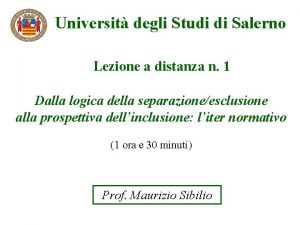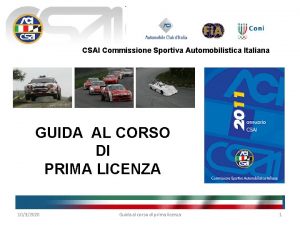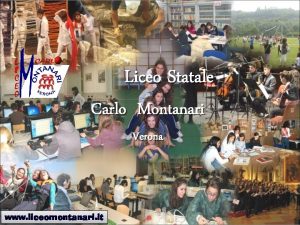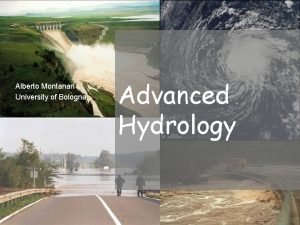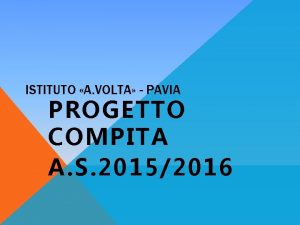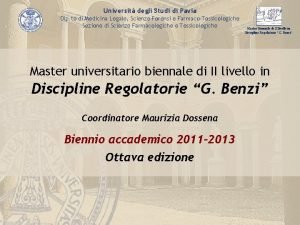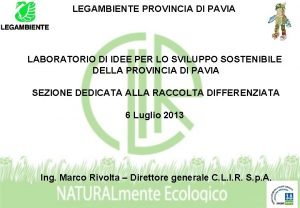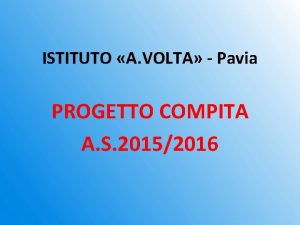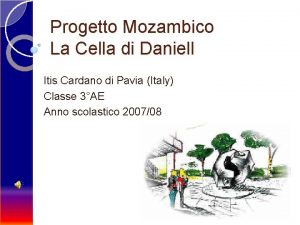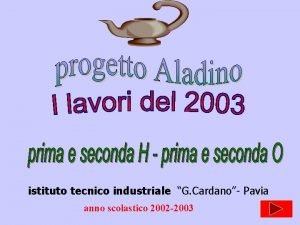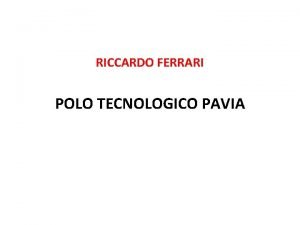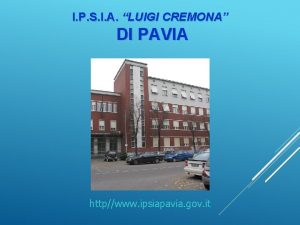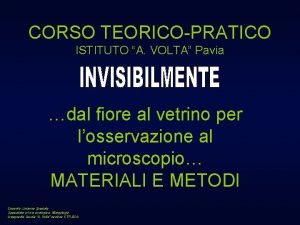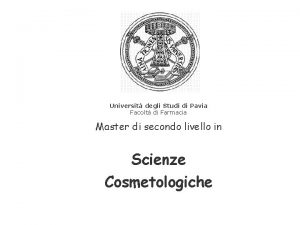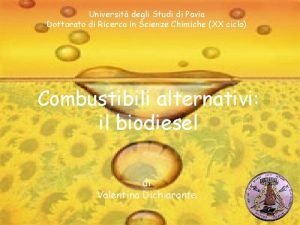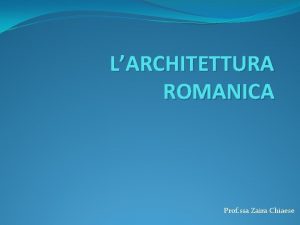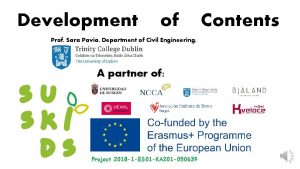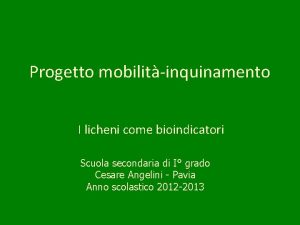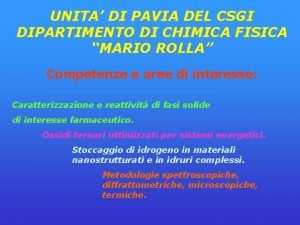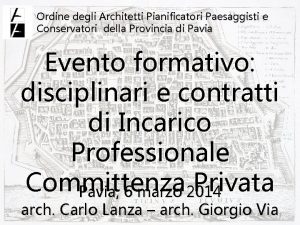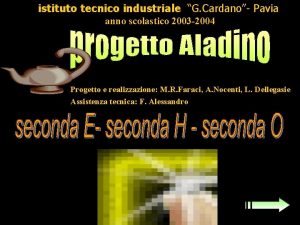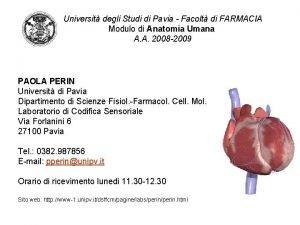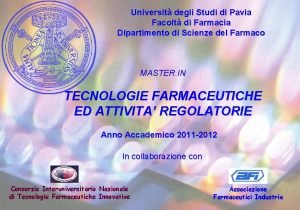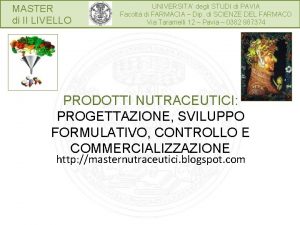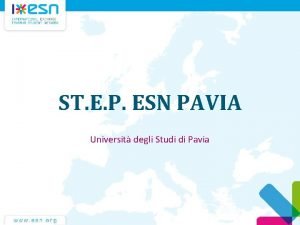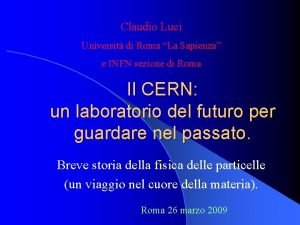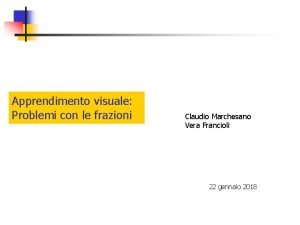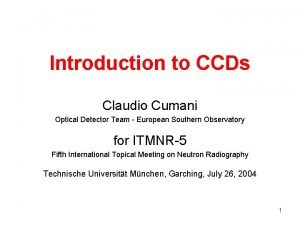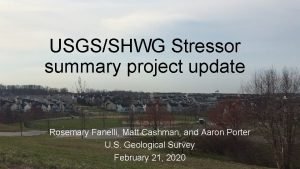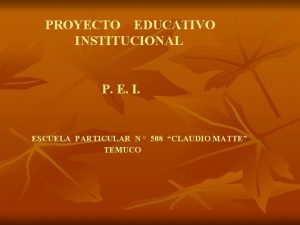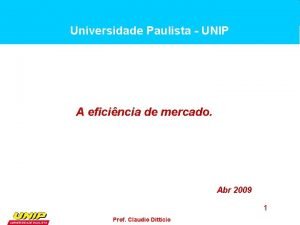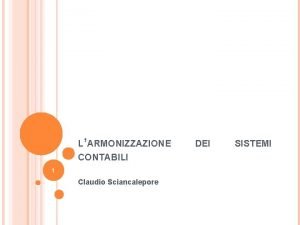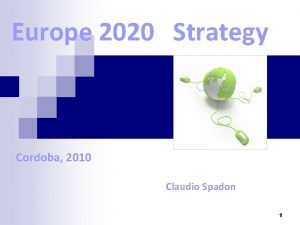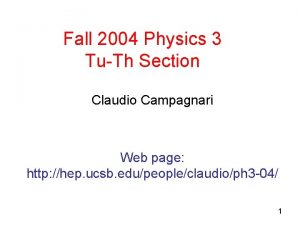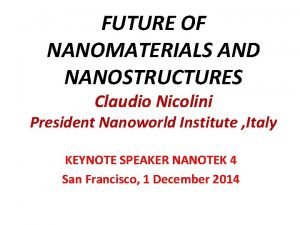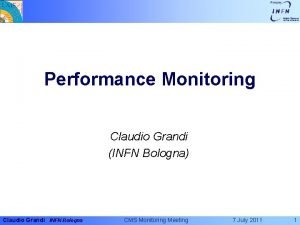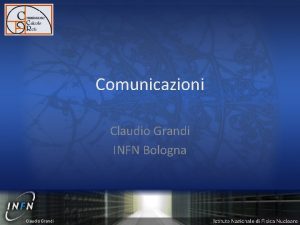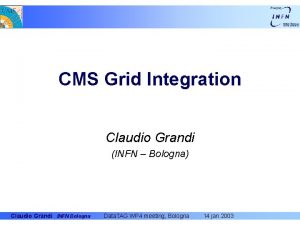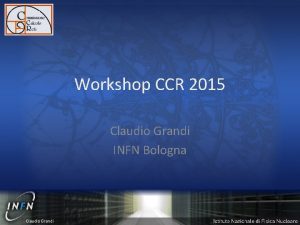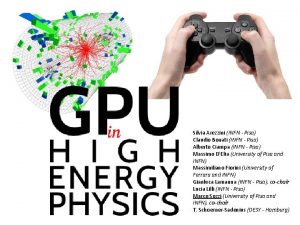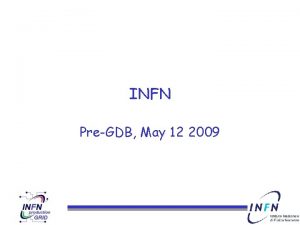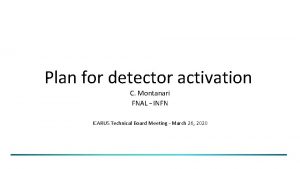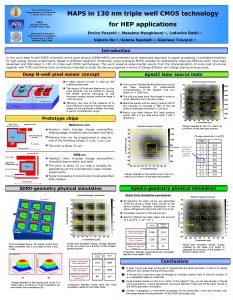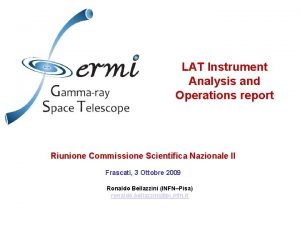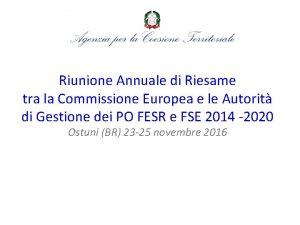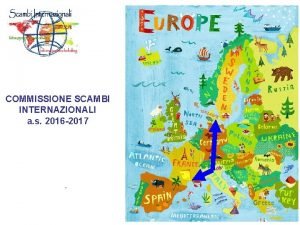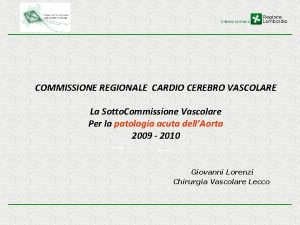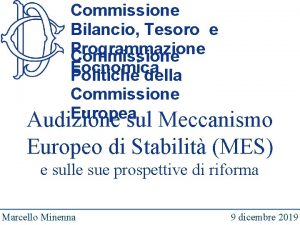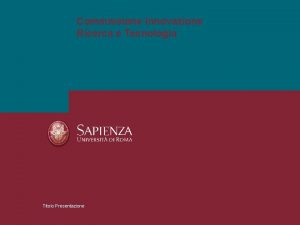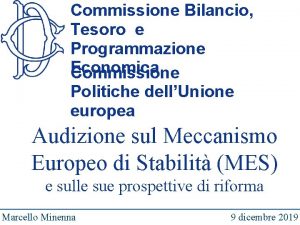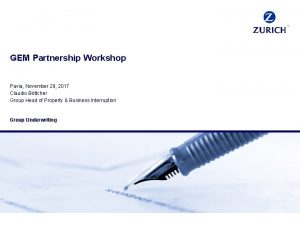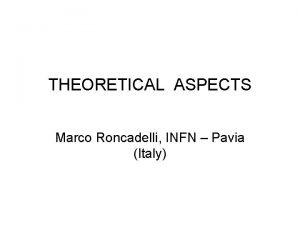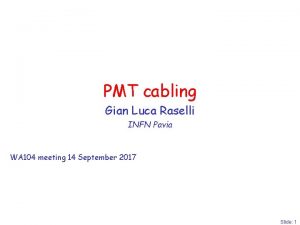Claudio Montanari INFN Pavia Riunione Commissione II 3








































- Slides: 40

Claudio Montanari INFN - Pavia Riunione Commissione II - 3 ottobre 2005 - Roma 1

The WARP Collaboration P. Benetti, E. Calligarich, M. Cambiaghi, C. De. Vecchi, L. Grandi, A. Menegolli, C. Montanari, M. Prata, A. Rappoldi, G. L. Raselli, M. Roncadelli, M. Rossella, C. Rubbia*, C. Vignoli INFN and Department of Physics at University of Pavia (Italy) F. Carbonara, A. G. Cocco, G. Fiorillo, G. Mangano, R. Santorelli INFN and Department of Physics at University of Napoli (Italy) F. Cavanna, N. Ferrari, O. Palamara, L. Pandola Laboratori Nazionali del Gran Sasso, INFN (Italy) F. Calaprice, C. Galbiati, Y. Zhao Princeton University (USA) A. Szelc Cracow University (Poland) Riunione Commissione II - 3 ottobre 2005 - Roma 2

The WARP Argon Detector A double phase Ar detector offers unique sensitivity for the search of Dark Matter in the form of WIMPs Ø Highest discrimination of background events, in favor of potential Wimp recoils. Two simultaneous criteria: 1. Both prompt scintillation and drift time-delayed ionisation are simultaneously detected, with a pulse ratio strongly dependent from columnar recombination of ionising tracks. The ionisation electrons are extracted from the liquid to the gas and accelerated by an appropriate electric field to produce a proportional (high gain), secondary light pulse seen by the same PM’s. 2. Pulse shape discrimination of primary scintillation, based on the very large difference in decay times between fast (≈ 10 ns) and slow (1. 6 µs) components of the emitted UV light. Ø Scintillation yield is of the order of ≈ 1 collected phe/ke. V and the detection WIMP threshold is about ≈ 30 ke. V. Ø Neutron background simulating Wimp recoils is rejected with the help of a large volume, 4π, LAr anticoincidence in which scintillation is also recorded. Riunione Commissione II - 3 ottobre 2005 - Roma -like event Slow component ≈ 70 % Recoil-like event Slow component ≈ 10 % 3

The WARP 100 liters chamber Ø The liquid argon final detector with a sensitive volume of 100 liters is expected to be operational by 2006. Ø In order to perfect the detection method, a 2. 3 liters test jig is in operation at the LNGS, since April 2004. Active Veto 100 liters Chamber Ø It is expected that the test detector may already reach competitive sensitivity levels. Ø The 100 liters detector will provide, in addition to the increased sensitive mass: the active VETO system, completely surrounding the 100 litres sensitive volume; 3 -D event localization by means of: Drift time recording (vertical axis); Centroid of PM’s secondary signal amplitudes (horizontal plane). Passive neutron and gamma shield Riunione Commissione II - 3 ottobre 2005 - Roma 4

2. 3 liters: 2005 setup Ø The 2. 3 liters prototype has been equipped with four 3” PMTs made of low background materials. ØVerified stable operation in LAr Ø Added an argon recirculation system for long lasting runs. ØImplemented a second level “intelligent” trigger system. The second level trigger is not actually inserted into the trigger logic but it is made to produce a tag signal that is recorded in the DAQ in order to evaluate its efficiency and stability ØThe analysis of the primary scintillation pulse shape has been added as criteria for event discrimination. ØThe installation includes a 10 cm lead shield for environmental gamma radiation ØStarting from September 2005 a neutron shield has been added made of polyethylene pipes to be filled with polyethylene grains. At this moment the lateral walls of the shield have been installed with the pipes still unfilled. Riunione Commissione II - 3 ottobre 2005 - Roma PMTs PEEK Supports Grids Waveshifter/Reflector Cathode Schematic view of the 2. 3 liters chamber 5

Discrimination technique l Minimum ionising particles are characterised by high S 2/S 1 ratio (~100) and by slow S 1 signal. particles and Ar recoils (R-like events) are characterised by low (<5) S 2/S 1 ratio and fast S 1 signal. Amplitude (a. u. ) l Events are characterized both by the primary (S 1) of secondary (S 2) amplitudes ratio and by the rising time of the S 1 signal. S 2 S 1 (A) Amplitude (a. u. ) l In the picture below two signals (A and B) correspond to two different signatures recorded in the chamber from minimum ionising event and a recoil nucleus, respectively. S 2 S 1 100 Minimum ionising particle Time (ms) (B) 100 Recoil nucleus Amplitude (a. u. ) l S 1 Time (ms) Riunione Commissione II - 3 ottobre 2005 - Roma Sum of PMT output after preamplifier Time (ms) S 1 Time (ms) 6

Rate (Hz) Total counting rate – May 2005 filling Rn analysis neutron analysis period I Shielding Rn decayed to top cover <5% of the added initial activity Chamber Riunione filling Commissione II - 3 ottobre 2005 - Roma Purity degradation 7

The combination of a selection based on S 2/S 1 ratio and rise time of primary scintillation gives an extremely poweful rejection power for the search of WIMPs signals. ’s and b’s No event outside the two circled regions ’s Complete agreement up to an observed level of ≈ 1/20000 combined rejection < 1/108 Ar recoils (expected) Riunione Commissione II - 3 ottobre 2005 - Roma 8

The 2. 3 liters chamber at LNGS Since March 2004 the chamber is installed in LNGS with the lead shield. Internal Structure of the 2. 3 liters Chamber Riunione Commissione II - 3 ottobre 2005 - Roma External lead shield (10 cm thick) 9

Rate (Hz) • 232 Th chain 0. 91 • 238 U chain 0. 45 • 60 Co 0. 19 • 40 K 0. 07 • 39 Ar + 85 Kr 2. 93 Total rate 4. 55 The most important source of internal background comes b decays of 39 Ar and 85 Kr inside the liquid Ar. There is a significant contribution from ray interactions produced by radioactivity of materials surrounding the sensitive volume. Riunione Commissione II - 3 ottobre 2005 - Roma Counts/sec/ke. V 2. 3 liters chamber : Observed total background rates Primary scintillation Experimental data MC simulation 85 Kr 39 Ar Energy (Me. V) Investigation about the possibility of argon isotopic separation, in order to reduce the 39 Ar contamination, is progressing. A Russian supplier has been identified with the capability, in principle, to reduce the 39 Ar content of at least a factor 100. A first sample of depleted argon has been produced and is now being measured to verify the residual 39 Ar content. 10

2. 3 liters chamber: analysis of Recoil-like events Primary scintillation (phe) Fiducial Volume Cathode region Data recorded during 13. 4 days of live time in the run done in june 2005 have been scanned looking for Recoil-like events. The picture shows the primary scintillation light (in phe) of all the selected Recoil-like data, along the drift time The total triggers analyzed are 6. 5 millions; 190 R-like events are selected inside the fiducial volume; 388 inside the cathode region. R-like events show a peculiar energy distribution along the drift volume with a characteristic clustering on the cathode region Riunione Commissione II - 3 ottobre 2005 - Roma We show that 1) R-like events on the cathode are mostly induced by 222 Rn and its daughters Drift time (ms) 2) R-like events inside the fiducial volume are induced by 11 environmental neutrons

1) R-like signals induced by 222 Rn Decay Chain Recoil energy = 110 ke. V Recoil energy = 144 ke. V is introduced in the chamber during the chamber filling mixed with Ar. 222 Rn is electrically neutral it is uniformly l distributed in the argon volume. l Daughter nuclei, produced into an ionized state, are drifted, by the electric field, to the cathode and to the, conically-shaped, chamber walls where they stick. l Subsequent decays may end up: with the heavy ion entering the cathode or the wall and the or the b traveling in the LAr; with the heavy ion travelling in the LAr: Recoil-like signal l 222 Rn Riunione Commissione II - 3 ottobre 2005 - Roma 12

The R-like events located on the cathode have an energy distribution which is well fitted by two gaussians centered at the energies ER, as expected from the decays: 218 Po --> 214 Pb (E =6. 0 Me. V, E =110 ke. V) R 214 Po --> 214 Bi (E =7. 7 Me. V, E =144 ke. V) R E R= 14 4 ke V E R= 11 0 k e. V Yields for Recoil-like events ≈ 0. 7 phe/ke. V Rn induced recoils in the cathode region are a powerful intrinsic calibration tool R-like events cathode - 1. 66 days just after chamber filling The sample is enriched in Rn induced signals Riunione Commissione II - 3 ottobre 2005 - Roma Energy (ke. V) (Y=0. 7 phe/ke. V) 13

The R-like event rate on the cathode decreases with the livetime of 222 Rn (5. 28 days) as shown in the following plot. After about 20 days after filling a constant counting rate is reached. In this conditions the signal is presumably produced by Rn emanation from the walls of the chamber and recirculation system. Neutron-like event recording (no neutron shielding) Radon calibration recording Riunione Commissione II - 3 ottobre 2005 - Roma 14

counts 2) R-like signals induced by neutrons Light yield=0. 7 phe/ke. V y m i l e r a n i Pr The plot shows the energy distribution of all R-like events inside the fiducial volume recorded during 13. 4 days of live time in June 2005, assuming a light yield of 0. 7 phe/ke. V for recoils as deduced from the analysis of 222 Rn signals. Both the event rate and the shape of the energy spectrum are compatible with the expected events induced by environmental neutrons inside the underground area. Energy (ke. V) Red points: R-like events inside fiducial volume (13. 4 days live time) Black histogram: Expected signal from Montecarlo simulation of environmental neutrons in the LNGS laboratory (input neutron spectrum from ref. Astrop. Phys. 22(2004) 313). Uncertainty is of the order of 20%. Blue histogram: expected residual signal from 222 Rn decays on the detector lateral walls Riunione Commissione II - 3 ottobre 2005 - Roma 15

Analysis of the WARP 2. 3 liters 2005 data with partial shielding for neutrons (Update 22 September 2005) Riunione Commissione II - 3 ottobre 2005 - Roma 16

Data taking May 2005 filling • • • Filling of the chamber : May 19, 2005 After some tests data taking started on May 21, 2005 The run was stopped on July 5, 2005 due to progressive degradation of the Ar purity. July 2005 filling • • Filling of the chamber : July 20, 2005 September 1 st – Lateral walls of the neutron shield completed (polyethylene pipes are still empty). Riunione Commissione II - 3 ottobre 2005 - Roma 17

2. 3 liters: Neutron shield Top Side Vertical part now completed. Order of polyethylene grains for filling signed at the beginning of October. Delivery expected in 10 days. Time needed for installation (pipes filling + top part) = 5 days. Riunione Commissione II - 3 ottobre 2005 - Roma 18

Total counting rate – July 2005 filling neutron analysis period II No data taking Riunione Commissione II - 3 ottobre 2005 - Roma Neutron shielding Poliethilene tubes Installed. Restart DAQ. 19

Primary scintillation spectra Riunione Commissione II - 3 ottobre 2005 - Roma 20

Primary scintillation spectra Riunione Commissione II - 3 ottobre 2005 - Roma 21

Contributions from single components JULY SEPTEMBER Rate (Hz) • 208 Tl 0. 15 • 212 Bi + 212 Pb 0. 16 • 214 Bi + 214 Pb 0. 46 • 214 Bi + 214 Pb 0. 76 • 60 Co 0. 19 • 40 K 0. 07 • 228 Ac 0. 60 • 39 Ar 1. 6 • 39 Ar 2. 2 • 85 Kr 1. 1 • 85 Kr 0. 9 Total rate II - 3 ottobre 20054. 33 Riunione Commissione - Roma Total rate 5. 03 22

Neutron induced signals Period 1 Data analyzed : runs 400 to 490 (9 jun - 29 jun) for a total live time of 13. 6 days. R-like events located in the fiducial volume (10<Td<35 ms) are selected. Total triggers analyzed: 6, 550, 970 (rate 5. 6 Hz) R-like signals selected by the automatic fit inside the fiducial volume: 406 R-like signals selected after visual scanning inside the fiducial volume: 190 (rate 0. 58 cph) Period 2 Data analyzed : runs 745 to 804 (2 sep - 14 sep) for a total live time of 10. 9 days. R-like events located in the fiducial volume (10<Td<35 ms) are selected. Total triggers analyzed: 5, 382, 822 (rate 5. 7 Hz) R-like signals selected by the automatic fit inside the fiducial volume: 195 R-like signals selected after visual scanning inside the fiducial volume: 40 (rate 0. 15 cph) Riunione Commissione II - 3 ottobre 2005 - Roma 23

Live time 13. 6 days Period I (no n shielding) m i l e r a in Energy (ke. V) Live time 10. 9 days Period II (partial n shielding) y y r a n i lim e r P Pr Drift time (ms) Energy vs drift time for the R-like events Riunione Commissione II - 3 ottobre 2005 - Roma 24

Energy distribution of R-like signals inside fiducial volume Period II (partial n shielding) Period I (no n shielding) y r ina 13. 9 events/day lim e r Light yield=0. 54 phe/ke. V Cpd/(5 ke. V) Light yield=0. 7 phe/ke. V lim e Pr P Trigger eff > 0. 1 y r ina 3. 7 events/day Trigger eff > 0. 1 Recoil Energy (ke. V) Black points: R-like events inside fiducial volume selected after visual scanning for runs 400 to 490 (13. 4 days live time) Red histogram: Expected signal from Montecarlo simulation of environmental neutrons in the LNGS laboratory (without n shielding). Data of bins up to 20 ke. V are divided by the trigger efficiency. Riunione Commissione II - 3 ottobre 2005 - Roma 25

S 2/S 1 Period II (partial n shielding) Period I (no n shielding) Preliminary S 2/S 1 vs Tp – fiducial volume Black points: all non saturated events inside the fiducial volume Red circles : selected inside the fiducial volume Riunione Commissione II - R-like 3 ottobreevents 2005 - Roma Tp 26

S 2/S 1 Period I (no n shielding) Period II (partial n shielding) Preliminary N e =1 N e =2 N e =3 N N e =5 e =4 Energy (ke. V) S 2/S 1 vs energy – fiducial volume Black points: all fast non saturated events inside the fiducial volume Red circles : selected inside the fiducial volume Riunione Commissione II - R-like 3 ottobreevents 2005 - Roma For min ion electrons Ionization = 20 el/ke. V Light yield Y=0. 35 phe/ke. V S 2/S 1=200 àEach ionization electron produces 3. 5 phe 27

Period I (no n shielding) Period II (partial n shielding) Preliminary cathode region Black points: all non saturated events in the cathode region Red circles : selected R-like events in the cathode region Riunione Commissione II - 3 ottobre 2005 - Roma 28

Muon induced neutron background • Neutrons induced by muon interactions in the rock or in the detector walls have been studied by means of two independent Montecarlo, one based on FLUKA and the other on GEANT 4, both for the 2. 3 liters and for the 100 liters setups. The two simulations give consistent results: – For the 2. 3 liters detector, with 50 cm polyethylene shield, about 1 event in ten days is expected from muon induced neutron interactions; about 80% of these events are rejected by means of a hodoscope placed on the top of the chamber setup. – For the 100 liters detector, also with 50 cm polyethylene shield, about 0. 7 events / day are expected, a large fraction of these events is rejected by the active shield (100%, for the simulated statistics, corresponding to about 1 month detector lifetime), and the predicted residual rate is, at the moment, < 0. 7 x 10 -4 event/kg/day. Riunione Commissione II - 3 ottobre 2005 - Roma 29

100 liters Detector Status of Construction Riunione Commissione II - 3 ottobre 2005 - Roma 30

100 litres Detector Layout GAr Recirculation Electronics cabinet Supporting Structure Neutron Shield (Polythene) Gamma Shield (Lead) Internal Shield (Polythene) Active Shield Riunione Commissione II - 3 ottobre 2005 - Roma Internal Detector 31

WARP 100 litres: Status of Construction • The 100 liters realization is proceeding according to the schedule, given the availability of the assigned installation space in Hall B foreseen for February 2006: – The detector mechanics (internal detector + active shield) are fully engineered: the internal detector construction is complete and the components for the active shield are under procurement, the delivery being expected by end of 2005. Also the internal polyethylene shield is under procurement. – R&D on photomultipliers with enhanced photocathode efficiency proceeded, in collaboration with the Manufacturer, with good results. New phototubes with photo-detection efficiency > 20% and stable operation at LAr temperature are under the final qualification tests in Naples (previous version had Q. E. ≈ 13%). Delivery of the phototubes for the internal detector will be completed before the end of 2005. Production, delivery and test of the phototubes for the active shield are scheduled for the first six months of 2006. Riunione Commissione II - 3 ottobre 2005 - Roma 32

Detector Mechanics: Inner detector Riunione Commissione II - 3 ottobre 2005 - Roma 33

Detector Mechanics: Active shield Riunione Commissione II - 3 ottobre 2005 - Roma 34

Detector Mechanics: PMTs holders Riunione Commissione II - 3 ottobre 2005 - Roma 35

Detector Mechanics: Internal Shield Riunione Commissione II - 3 ottobre 2005 - Roma 36

Setup for PMT tests in LN 2 at ETL Setup put on by Electron Tubes Ltd during the summer for single PMT test in LN 2 All resistive divider held close to room temperature. Blue LED light sources, optic-fibre light input with reference pmts to monitor LED intensity. Riunione Commissione II - 3 by ottobre 2005 - Roma LN 2 level controlled thermocouple. 37

WARP 100 litres: Status of Construction (cont. ) • – Procurement of the main cryostat has started. Delivery to LNGS is planned for the end of February 2006. Additional cryogenic components (purification and recirculation systems, auxiliary circuits) are fully designed and will be acquired at the beginning of 2006. – The external passive shield is almost fully engineered, including the LNGS prescriptions for anti-seismic and safety. Materials procurement will proceed during Autumn 2005 for delivery and start assembly in LNGS in February 2006. – High voltage distribution systems are under test. – The design of readout electronics is being finalized. Pre-series production and test is expected by end 2005 / beginning 2006. Mass production is foreseen for the first six months 2006. • Design, construction and test of readout electronics are under the responsibility of the Princeton group. A request is being submitted to NSF for the corresponding funding (≈ 300 k€). Construction of the 100 liters detector is expected to be be completed at about mid 2006. Riunione Commissione II - 3 ottobre 2005 - Roma 38

100 liters WARP Detector Construction and Deployment Schedule Riunione Commissione II - 3 ottobre 2005 - Roma 39

Conclusions (from N. Ferrari presentation to TAUP 2005) • The Wimp Argon Programme has started at LNGS • The WARP 100 liters detector is fully designed and it is going to be installed at LNGS during 2006 • The WARP 2. 3 liters chamber is in operation at LNGS demonstrating the effectiveness of the double discrimination technique; • First results of the 2. 3 liters test without neutron shield show that the signal of R-like events is compatible with the expected neutron background in the underground area • Next step will be operation with the neutron shield. . …. If you wish to know more details, more time is necessary ! Riunione Commissione II - 3 ottobre 2005 - Roma 40
 Conferenza di salamanca
Conferenza di salamanca Gallina commissione europea
Gallina commissione europea Commissione sportiva automobilistica italiana
Commissione sportiva automobilistica italiana Liceo statale carlo montanari verona
Liceo statale carlo montanari verona Alberto montanari
Alberto montanari Claudia montanari radiata
Claudia montanari radiata Pacinotti scafati
Pacinotti scafati Dipartimento di chimica pavia
Dipartimento di chimica pavia Istituto volta pavia
Istituto volta pavia Master farmacovigilanza pavia
Master farmacovigilanza pavia Legambiente pavia
Legambiente pavia Volta pavia
Volta pavia Itis cardano pavia
Itis cardano pavia Istituto tecnico cardano pavia
Istituto tecnico cardano pavia Polo tecnologico pavia
Polo tecnologico pavia Ipsia l cremona
Ipsia l cremona Istituto volta pavia
Istituto volta pavia Master scienze cosmetologiche pavia
Master scienze cosmetologiche pavia Dottorato di ricerca pavia
Dottorato di ricerca pavia Claristerio
Claristerio Sara pavia
Sara pavia Scuola media angelini pavia
Scuola media angelini pavia Dipartimento chimica unipv
Dipartimento chimica unipv Ordine architetti pavia
Ordine architetti pavia Dipartimento psicologia pavia
Dipartimento psicologia pavia Istituto superiore cardano milano
Istituto superiore cardano milano Kiro giurisprudenza unipv
Kiro giurisprudenza unipv Tfar pavia
Tfar pavia Master farmacia pavia
Master farmacia pavia Esn pavia
Esn pavia Luci sapienza
Luci sapienza Claudio marchesano
Claudio marchesano Claudio storelli
Claudio storelli Claudio cumani
Claudio cumani Rosemary fanelli
Rosemary fanelli Colegio claudio matte temuco
Colegio claudio matte temuco Claudio ditticio
Claudio ditticio Claudio sciancalepore
Claudio sciancalepore Spadon claudio
Spadon claudio Claudio campagnari ucsb
Claudio campagnari ucsb Claudio nicolini
Claudio nicolini
